Rheasilvia
Coordinates: 75°S 301°E / 75°S 301°E[1]
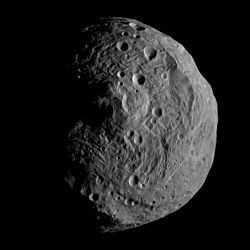
Rheasilvia /ˌriːəˈsɪlviə/ is the most prominent surface feature on the asteroid Vesta and is believed to be an impact crater. It is 505 kilometres (314 mi) in diameter, which is 90% the diameter of Vesta itself,[2] making it one of the largest craters in the Solar System, and at 75°S latitude, covers most of the southern hemisphere. It partially obscures an earlier crater, named Veneneia, that at 395 kilometres (245 mi) is almost as large.[3] It was discovered in Hubble images in 1997,[4] but was not named until the arrival of the Dawn spacecraft in 2011. It is named after Rhea Silvia, a mythological vestal virgin and mother of the founders of Rome.[1]
Rheasilvia has an escarpment along part of its perimeter which rises 4–12 km above the surrounding terrain. The crater floor lies about 13 kilometres (8.1 mi) below the surrounding surface. This basin consists of undulating terrain and a central mound, almost 200 kilometres (120 mi) in diameter, which rises 22 kilometres (14 mi) from its base,[5] the tallest mountain known in the Solar System. Spectroscopic analyses of Hubble images have shown that this crater has penetrated deep through several distinct layers of the crust, and possibly into the mantle, as indicated by spectral signatures of olivine.[6]
Vesta has a series of troughs in an equatorial region concentric to Rheasilvia. These are believed to be large-scale fractures resulting from the impact. The largest is Divalia Fossa, approx. 22 km wide and 465 km long.
It is estimated that the impact responsible excavated about 1% of the volume of Vesta, and it is likely that the Vesta family and V-type asteroids are the products of this collision. If this is the case, then the fact that 10-km fragments have survived bombardment until the present indicates that the crater is at most about 1 billion years old.[7] It would also be the origin of the HED meteorites. Known V-type asteroids account for 6% of the ejected volume, with the rest of the fragments presumably either too small to observe, or removed from the asteroid belt by approaching the 3:1 Kirkwood gap, by the Yarkovsky effect, or (in the case of small fragments) by radiation pressure.
Gallery
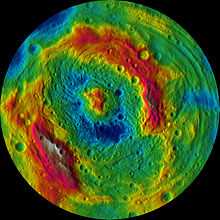 Elevation map of Vesta's southern hemisphere. Higher elevations (red) are found on the crater rim (occluding Veneneia) and the central peak. |
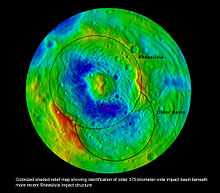 Outlines of Rheasilvia and Veneneia, the latter being partially obliterated by the former. |
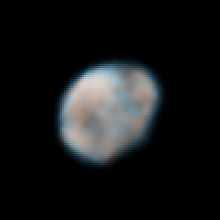 Hubble image of Vesta from May 2007. The flat spot at lower right is Rheasilvia seen in profile. |
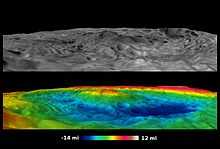 Computer-generated oblique view of Rheasilvia, with color-coded elevation in the lower version. A flyover video is available at the source. |
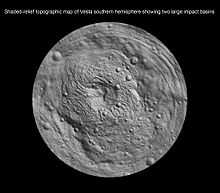 Shaded-relief topographic map of Vesta's southern hemisphere, showing Rheasilvia and Veneneia. |
 3-D anaglyph image of Rheasilvia's central peak. |
References
- ↑ 1.0 1.1 Blue, Jennifer. "Rheasilvia". Gazetteer of Planetary Nomenclature. USGS Astrogeology Research Program. (NASA coordinates)
- ↑ It is 95% the mean diameter of Vesta, 529 km. However, the mean is affected by the crater itself. It is 89% the mean equatorial diameter of 569 km.
- ↑ 'Vesta seems more planet than asteroid', Science News, 2012 Mar 22
- ↑ Hubble Reveals Huge Crater on the Surface of the Asteroid Vesta
- ↑ Vega, P. (2011-10-11). "New View of Vesta Mountain From NASA's Dawn Mission". Jet Propulsion Lab's Dawn mission web site. NASA. Retrieved 2012-03-29.
- ↑ Thomas, P. C. et al. (1997). "Vesta: Spin Pole, Size, and Shape from HST Images". Icarus 128 (1): 88. Bibcode:1997Icar..128...88T. doi:10.1006/icar.1997.5736.
- ↑ Binzel, R. P. et al. (1997). "Geologic Mapping of Vesta from 1994 Hubble Space Telescope Images". Icarus 128 (1): 95. Bibcode:1997Icar..128...95B. doi:10.1006/icar.1997.5734.